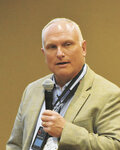

WISCONSIN DELLS, Wis. — As margins continue to be tight on dairy farms, farmers may look for ways to increase efficiency and strive to keep losses at a minimum.
Feed shrink and waste can cost a dairy farm a lot of money. But, dairy farmers can improve their bottom line by paying close attention to the smallest details.
Jamie St. Pierre and Ben Palmer, of Pleasant Valley Farm of Berkshire LLC, in Berkshire, Vermont, and Kurt Wierda, of Le Mars, Iowa, sat down to share what they are doing to combat feed shrink and loss on their respective dairies at the PDP Business Conference March 14 in Wisconsin Dells.
“Shrink: We all have it, and we all try our best to manage it,” Wierda said. “I really try to pick my battles in terms of what I can and can’t do. There are some things I can control and some that I just can’t control.”
The three men agreed that shrink has been a real issue for their farms, but they have had success reducing it with careful attention.
“I figure I have about 8%-10% shrink on my corn silage from what comes across the scale versus what I feed,” Wierda said. “The ingredients in the commodity shed all differ a little bit but are about 2%-2.5% overall.”
Palmer, operations manager of Pleasant Valley Farm of Berkshire, said the feeding center made a huge difference in the amount of shrink they experienced.
“Before the feeding center, I figured we were at least at 15% shrink, and now I would say we’re down to about 2%-3% shrink,” Palmer said. “We don’t track our forage shrink as much as we should.”
Wierda is the general manager and a partner in two dairies in western Iowa. Plymouth Dairy, built in 2000, is a 3,300-cow facility, with cows being milked in a double-40 parallel parlor. Perry Creek Dairy is a recently built tunnel-ventilated barn with an 80-stall rotary parlor, with 5 acres under the roof. The farm is home to 4,300 cows.
“We have state-certified scales on both farms, and everything is weighed in and out,” Wierda said. “All of that information is downloaded into the computer. We use that data to help track our inventory and monitor shrink.”
To make the most of his feeding dollars, Wierda said he tries to buy his ingredients in the largest quantities possible. He also keeps a close eye on accurately monitoring feed inventories and looks for places one might not expect to find waste and shrink.
“When we’re chopping corn, some of the cutters might have a hard time hitting the box, and silage accumulates on the truck that never gets unloaded,” Wierda said. “I give those drivers two options: clean off the truck or get an empty weight. If one truck has 500 pounds of corn silage that never gets unloaded, and I have 20 trucks and we chop for 14 days, that 500 pounds of silage comes out to 140,000 pounds, or 70 tons, of silage that the computer says I have that I really don’t. That’s real shrink.”
Wierda said an audit done by his nutritionist also helped hone areas where shrink and other waste were occurring that he might not have thought of, such as fuel waste.
“One thing that came out of the audit was when the payloader and the trucks were left running when not in use,” Wierda said. “That is something you might not think about.”
St. Pierre is the dairy operations supervisor on his family’s northwestern Vermont dairy farm. Located near the Canadian border, the farm is home to 6,800 cows milked on three sites. He said the challenges they face due to location, topography and climate make shrinkage very costly.
Temperatures throughout the year in this area range from 90 degrees in the summer to 30 degrees below zero in the winter. Typically, they receive about 40 inches of rain and 90 inches of snow each year.
“We have a short growing season for making silage,” St. Pierre said. “We can have our last frost of the year as late as May 10 and our first frost as early as Sept. 15. We have to travel a long way to make enough forage for our herd, as much as 25-30 miles. If it is a sunny day in the summer, we’re making hay silage to have enough forage for our cows. We get plenty of wind. Mixing outside creates a lot of shrink from the wind, rain and snow.”
With the variability in their ability to make consistent quality forages, the St. Pierres tend to rely on corn as the basis of their rations.
“Our corn prices are always higher, because of our distance from the corn belt,” St. Pierre said. “A point of shrink in Vermont costs a lot more than a point of shrink in Iowa.”
The St. Pierre family takes advantage of their proximity to Canadian small grain farmers and tries to buy directly from those growers as much as possible. They have begun grinding all their ingredients on-site to reduce loading and unloading costs as well.
Purchasing their ingredients as they do has benefited the St. Pierres, but it has also come with its own set of challenges.
“We have more inventory on hand to ensure we have enough feed available because of the flexibility of our suppliers,” St. Pierre said. “Our bays are sized for about 200 tons each, so that makes storing, managing and monitoring that inventory a challenge.”
Those factors led the St. Pierre family to see the value of building a feed center under one roof in 2019 to help eliminate the variables that cause shrinkage and improve their feeding efficiency.
“When we built the feed center, we thought, ‘Oh, it’s going to cost a lot of money,’” St. Pierre said. “But in reality, it paid for itself within the first 6-9 months with the reduced loss from shrinkage and the increased labor efficiency.”
Comments
No comments on this item Please log in to comment by clicking here